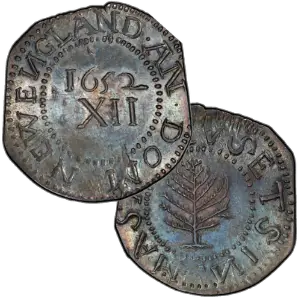The early colonial coinage in America refers to the coins that were minted and circulated in the North American colonies before the establishment of the United States Mint in 1792. During the colonial period, there was a shortage of official British currency in the American colonies, leading to a reliance on a variety of alternative forms of money, including foreign coins, tokens, and locally-produced coinage.
Here are some key points about early colonial coinage:
Foreign Coins: Due to the lack of a mint in the colonies, various foreign coins, such as Spanish pieces of eight, Dutch guilders, and Portuguese coins, were widely used in everyday transactions. These coins were accepted at different rates depending on their metal content and perceived value.
Colonial Tokens: In the absence of sufficient official coinage, some individual colonies and private individuals issued their own tokens as a form of local currency. These tokens were often made of copper and were used in local trade. Examples include the Rosa Americana coinage of Connecticut and the Willow Tree coinage of Massachusetts.
Higley Copper: In the early 1730s, Dr. Samuel Higley of Connecticut minted a series of copper coins known as Higley coppers. These coins featured a variety of designs, including a beehive and a harp. They were produced in limited quantities and are now considered rare and valuable.
Virginia Halfpenny: In the mid-18th century, the Virginia colonial government authorized the minting of a series of copper halfpennies to address the shortage of small change. These coins featured the image of King George II and the word "Virginia." They were not widely accepted and are relatively scarce today.
Fugio Cent: In 1787, the United States Congress authorized the minting of the Fugio cent, which is often considered one of the first official coins of the United States. Designed by Benjamin Franklin, these copper coins featured a sundial and the motto "Fugio" (Latin for "I fly" or "I flee"). The reverse side displayed thirteen linked rings symbolizing the unity of the thirteen colonies.
It's important to note that the establishment of the U.S. Mint in 1792 marked a significant turning point in American coinage, leading to the production of official and standardized coins for the new nation. Before this, the variety of coins and tokens circulating in the colonies reflected the diverse economic and cultural influences of the time.
The Massachusetts Bay Colony (1652): The Massachusetts Bay Colony is known for producing the first coins in British North America. In 1652, the General Court of Massachusetts authorized the production of the Massachusetts Bay Colony silver coinage. These coins were primitive and hand-cut, featuring the iconic tree design on one side and the denomination on the other.
The Willow Tree Coinage (1653-1660): Following the Massachusetts Bay Colony coinage, the minting of the Willow Tree coinage took place between 1653 and 1660. These coins featured a willow tree on one side and the denomination on the other. Again, these coins were crudely produced and not widely accepted.
The Oak Tree Coinage (1660-1667): The Oak Tree coinage succeeded the Willow Tree coinage, and it featured an oak tree on one side. The coins were more sophisticated than their predecessors, and the designs were more standardized.
The Pine Tree Coinage (1667-1682): The Pine Tree coinage replaced the Oak Tree series and is considered one of the most aesthetically pleasing early colonial coinages. The coins featured a pine tree on one side and the denomination on the other.
Other Colonial Coinages: Other colonies also attempted to produce their own coinage, including Connecticut, New Jersey, and Maryland. However, these coins were not as widespread as those from Massachusetts.
Regulatory Issues and British Control: The British Crown, concerned about the potential for independent colonial currencies, passed several laws in the late 17th and early 18th centuries to regulate and control colonial coinage. This led to the end of many colonial minting efforts, and colonists increasingly relied on British and foreign coins.
Spanish Dollar as a Standard: The Spanish dollar (pieces of eight) became the de facto standard currency in the American colonies due to its wide acceptance and consistent value. The Coinage Act of 1792 in the newly independent United States officially adopted the Spanish dollar as the basis for the U.S. monetary system.
The history of early colonial coinage in America reflects the challenges of creating a stable currency in a new and rapidly developing society. The reliance on foreign coins and the eventual standardization of currency after independence laid the groundwork for the development of the U.S. monetary system.

